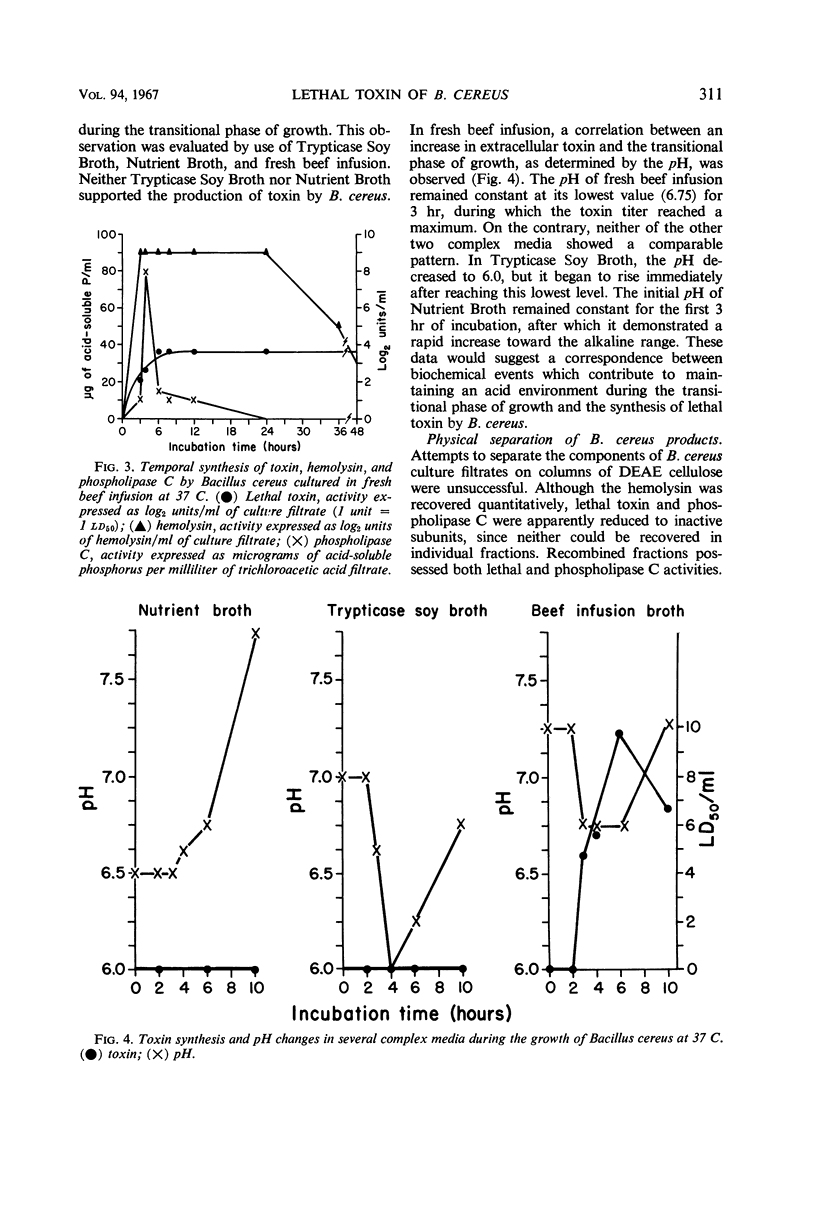Abstract
Bacillus cereus phospholipase was characterized as a phospholipase C by the analysis of lecithin degradation products by thin-layer and paper chromatography. Methanol in the growth menstruum inhibited completely the synthesis of phospholipase C, whereas the synthesis of lethal toxin and hemolysin were only partially inhibited. Dialysis of preformed B. cereus products against ethyl alcohol and methanol did not inactivate hemolytic, phospholipase C, or lethal activity. The hemolytic and lethal activities of culture filtrates were completely abolished by trypsin, but phospholipase C activity was resistant to inactivation. Lethal and phospholipase C properties of culture filtrates were resistant to inactivation at 45 C, whereas the hemolytic activity was completely destroyed. Lethal, hemolytic, and phospholipase C activities appeared simultaneously in a complex growth menstruum, but the kinetics of synthesis were different in all cases. Resolution of B. cereus filtrates on columns of Sephadex showed that the phospholipase C, hemolysin, and lethal toxin are distinct proteins. Evidence is also presented which suggests a correlation between the synthesis of B. cereus toxin and the period of transition from vegetative growth to sporulation. The activity of each B. cereus product was cation-independent, as opposed to cation-dependency of the phospholipase C and lethal activities of Clostridium perfringens α-toxin. Immunological cross-reactivity between the B. cereus products and C. perfringens α-toxin was not apparent; indeed, they were shown to be antigenically distinct.
Full text
PDF










Selected References
These references are in PubMed. This may not be the complete list of references from this article.
- BAKER H., SOBOTKA H. Growth requirements of some thermophilic and mesophilic Bacilli. J Gen Microbiol. 1953 Dec;9(3):485–493. doi: 10.1099/00221287-9-3-485. [DOI] [PubMed] [Google Scholar]
- BONVENTRE P. F., ECKERT N. J. Toxin production as a criterion for differentiating Bacillus cereus and Bacillus anthracis. J Bacteriol. 1963 Feb;85:490–491. doi: 10.1128/jb.85.2.490-491.1963. [DOI] [PMC free article] [PubMed] [Google Scholar]
- Clark F. E. The Relation of Bacillus siamensis and Similar Pathogenic Spore-forming Bacteria to Bacillus cereus. J Bacteriol. 1937 Apr;33(4):435–443. doi: 10.1128/jb.33.4.435-443.1937. [DOI] [PMC free article] [PubMed] [Google Scholar]
- Curtis J. R., Wing A. J., Coleman J. C. Bacillus cereus bacteraemia. A complication of intermittent haemodialysis. Lancet. 1967 Jan 21;1(7482):136–138. doi: 10.1016/s0140-6736(67)91036-7. [DOI] [PubMed] [Google Scholar]
- DAWSON R. M. The reported occurrence of sphingosylphosphorylcholine in animal tissues. Biochem J. 1958 Feb;68(2):357–360. doi: 10.1042/bj0680357. [DOI] [PMC free article] [PubMed] [Google Scholar]
- FOSSUM K. SEPARATION OF HEMOLYSIN AND EGG YOLK TURBIDITY FACTOR IN CELL-FREE EXTRACTS OF BACILLUS CEREUS. Acta Pathol Microbiol Scand. 1963;59:400–406. doi: 10.1111/j.1699-0463.1963.tb01810.x. [DOI] [PubMed] [Google Scholar]
- HANES C. S., ISHERWOOD F. A. Separation of the phosphoric esters on the filter paper chromatogram. Nature. 1949 Dec 31;164(4183):1107-12, illust. doi: 10.1038/1641107a0. [DOI] [PubMed] [Google Scholar]
- HANSON R. S., SRINIVASAN V. R., HALVORSON H. O. Biochemistry of sporulation. I. Metabolism of acetate by vegetative and sporulating cells. J Bacteriol. 1963 Feb;85:451–460. doi: 10.1128/jb.85.2.451-460.1963. [DOI] [PMC free article] [PubMed] [Google Scholar]
- HASHIMOTO T., BLACK S. H., GERHARDT P. Development of fine structure, thermostability, and dipicolinate during sporogenesis in a bacillus. Can J Microbiol. 1960 Apr;6:203–212. doi: 10.1139/m60-022. [DOI] [PubMed] [Google Scholar]
- JAYKO L. G., LICHSTEIN H. C. Effect of alcohols on lecithinase of Clostridium perfringens. Proc Soc Exp Biol Med. 1958 May;98(1):63–64. doi: 10.3181/00379727-98-23941. [DOI] [PubMed] [Google Scholar]
- KNIGHT B. C. J. G., PROOM H. A comparative survey of the nutrition and physiology of mesophilic species in the genus Bacillus. J Gen Microbiol. 1950 Sep;4(3):508–538. doi: 10.1099/00221287-4-3-508. [DOI] [PubMed] [Google Scholar]
- KUSHNER D. J. Effect of alcohols on the synthesis of lecithinase by Bacillus cereus. Nature. 1957 Apr 13;179(4563):781–782. doi: 10.1038/179781a0. [DOI] [PubMed] [Google Scholar]
- KUSHNER D. J. The effect of alcohols on the synthesis of lipase, lecithinase and other enzymes by Bacillus cereus. Biochem J. 1960 May;75:386–395. doi: 10.1042/bj0750386. [DOI] [PMC free article] [PubMed] [Google Scholar]
- King E. J. The colorimetric determination of phosphorus. Biochem J. 1932;26(2):292–297. doi: 10.1042/bj0260292. [DOI] [PMC free article] [PubMed] [Google Scholar]
- MOLNAR D. M. Separation of the toxin of Bacillus cereus into two components and nonidentity of the toxin with phospholipase. J Bacteriol. 1962 Jul;84:147–153. doi: 10.1128/jb.84.1.147-153.1962. [DOI] [PMC free article] [PubMed] [Google Scholar]
- Macfarlane M. G., Knight B. C. The biochemistry of bacterial toxins: The lecithinase activity of Cl. welchii toxins. Biochem J. 1941 Sep;35(8-9):884–902. doi: 10.1042/bj0350884. [DOI] [PMC free article] [PubMed] [Google Scholar]
- Ottolenghi A. C. Phospholipase C from Bacillus cereus, a zinc-requiring metalloenzyme. Biochim Biophys Acta. 1965 Dec 2;106(3):510–518. doi: 10.1016/0005-2760(65)90067-6. [DOI] [PubMed] [Google Scholar]
- SLEIN M. W., LOGAN G. F., Jr Partial purification and properties of two phospholipases of Bacillus cereus. J Bacteriol. 1963 Feb;85:369–381. doi: 10.1128/jb.85.2.369-381.1963. [DOI] [PMC free article] [PubMed] [Google Scholar]
- STOPLER T., CAMUESCU V., VOICULESCU M. BRONHOPNEUMONIE CU EVOLU TIE LETAL A PROVOCAT A DE UN MICROORGANISM DIN GENUL BACILLUS (B. CEREUS) Microbiol Parazitol Epidemiol (Bucur) 1964 Sep-Oct;25:457–460. [PubMed] [Google Scholar]
- Slein M. W., Logan G. F. Characterization of the Phospholipases of Bacillus cereus and Their Effects on Erythrocytes, Bone, and Kidney Cells. J Bacteriol. 1965 Jul;90(1):69–81. doi: 10.1128/jb.90.1.69-81.1965. [DOI] [PMC free article] [PubMed] [Google Scholar]


